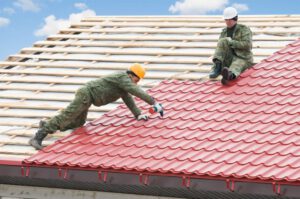Roofs are made of a variety of materials. One is asphalt, a bituminous organic material, that is used to make shingles and composition shingles. Roofing materials also have varying levels of fire resistance. There is an organization of testing laboratories that develops standards, testing procedures, and specifications for construction. Many city building codes also use these standards to guide the installation of roofs. Asphalt roofs have a high chance of blistering. You can Visit the Website to learn more about different roofing materials.
 Despite their varied properties, roofing materials have long been used to protect buildings from the elements. Seagrass is a popular choice for roofing because of its high durability. Bamboo is another popular material. In many countries, bamboo is used for both its inner structure and outer layer. Split bamboo stems are laid alternately or overlapped. Other materials include wooden shingles, which are most common in areas with plenty of timber. Even the bark of certain trees is sometimes used as a roofing material. While it may be tempting to replace your entire roof, it is not a good idea in some cases. Roofing contractors typically charge more for this process than they do for reroofing. This is because reroofing does not require tearing off your old roof. Therefore, it is less expensive and takes less time. Roofing contractors should evaluate the severity of your roof before deciding on the best option for you. The cost of reroofing your home is much lower than a full roof replacement.
Despite their varied properties, roofing materials have long been used to protect buildings from the elements. Seagrass is a popular choice for roofing because of its high durability. Bamboo is another popular material. In many countries, bamboo is used for both its inner structure and outer layer. Split bamboo stems are laid alternately or overlapped. Other materials include wooden shingles, which are most common in areas with plenty of timber. Even the bark of certain trees is sometimes used as a roofing material. While it may be tempting to replace your entire roof, it is not a good idea in some cases. Roofing contractors typically charge more for this process than they do for reroofing. This is because reroofing does not require tearing off your old roof. Therefore, it is less expensive and takes less time. Roofing contractors should evaluate the severity of your roof before deciding on the best option for you. The cost of reroofing your home is much lower than a full roof replacement.
Roofing materials come in different types. Asphalt-saturated felt was the most common up until 15 years ago. However, synthetic products have gained popularity since then. The most common roofing underlayment used until then was asphalt-saturated felt. Today, synthetic products have been widely used, including bitumen-based roofing underlayment. But if you are looking for something more modern and durable, try synthetic products. A great choice is a blend of asphalt and natural plant fibers.
Shingles are the most visible part of the roofing. They are rectangular pieces of roofing material laid in courses. The shingles overlap the joints below. Roofing materials can be made from a variety of materials, including wood, slate, flagstone, rubber, and copper. While shingles are the most common roofing materials, they deteriorate much faster than wall shingles. They are also the most expensive. So, make sure that you choose a quality roofing material.
Luckily, there are several ways to extend your warranty. You can purchase extended warranties for shingles, underlays, and eaves membranes. These warranties can cover your roof for up to 50 years. But be sure to hire a certified roofer to install the warranty. Some warranties will void if improper ventilation or decking is present. Having a warranty on a roof is worth the extra money. This way, you can save it for a rainy day or even a vacation.
You should consider replacing your roof if it is more than 20 years old. Not only will a new roof protect your home from the elements, but it will also add value and curb appeal. Choose from asphalt, wood, corrugated steel, terra cotta tile, or corrugated iron roofing. If you’re not sure which type to choose, ask a professional. You can also choose a roofing contractor based on the area where you live.
Poorly insulated roofing is another common cause of water damage. Warm air inside the home melts snow on the roof, which then gets refrozen as it falls over the colder overhang. If you have ice dams, the water can enter your home and damage insulation, walls, and ceilings. Roofing professionals can install an ice dam protection membrane and roofing felt to prevent leaks and protect your home. You can also install a water-resistant ice barrier.
Another option is bridging. This method is referred to as butting up. To do this, shingles are overlapped and nailed to each other, a technique called bridging. In addition, bridging is used for low-sloped roofing. In addition, cap flashing prevents water from passing behind the base flashing. Generally, cap flashing is not changed during a reroofing job. Ultimately, it is more convenient to consult with your roofing contractor.
